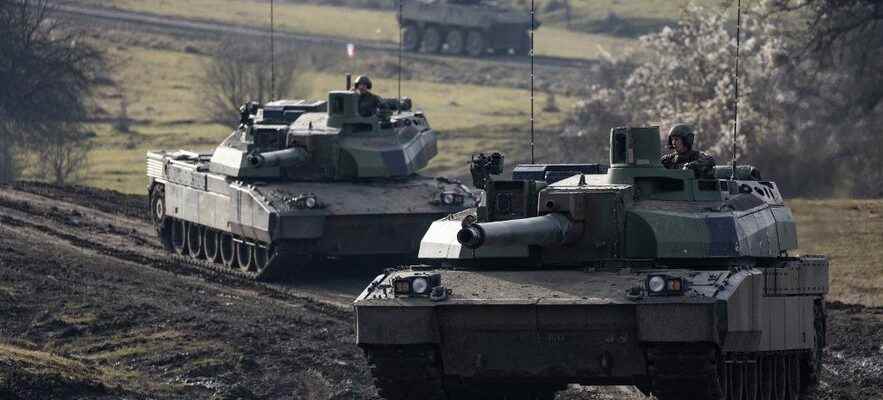After weeks of hesitation, Germany finally took the plunge. This Wednesday, January 25, German Chancellor Olaf Scholz announced to authorize the delivery of Leopard 2 tanks to Ukraine. The end of an interminable showdown when, for several weeks, many Western allies had been urging Berlin to give the green light to the export of these armored vehicles, which kyiv is crying out for. It’s done, but now what will happen? Can they really be a game-changer on the battlefield? Will France follow suit and send Leclerc tanks to Ukraine? The answers of François Heisbourg, special adviser to the Foundation for Strategic Research.
L’Express: Is Berlin’s decision to send Leopard 2 tanks to Ukraine a turning point in the conflict?
Francois Heisbourg: This is an important milestone in the military aid provided to Ukraine, both materially and symbolically. But we come a long way. Until then, 12 countries asked Berlin for permission to deliver these German-made tanks to Ukraine, but Germany refused to do so. German Chancellor Olaf Scholz’s inflection made it possible to resolve this disagreement, which had ended up putting him in a very delicate position. Now we have to see the total number of Leopard 2 tanks that will be delivered to Ukraine, beyond the 14 announced by Germany.
If there is a strong mobilization of other countries, we could quickly have 100 to 200. Which would ultimately not be so far from the 300 tanks claimed by the Ukrainians. In addition, there are also the 14 Challenger 2s that the British have already announced. And it is expected that the United States will in turn announce a batch of M1 Abrams, tanks even more modern than the Leopard 2. If so, it would be a hit for Ukraine.
Concretely, what will this contribution change for the Ukrainian forces?
This will allow them to wage a fight on equal terms against the Russians. Until now, the Ukrainians did not really have the capacity to carry out armored counter-offensives. Thus, the previous Ukrainian offensives to liberate Kherson and the province of Kharkiv were not based on the massive use of tanks, due to the scarcity of this type of material in the Ukrainian arsenal. With Western tanks, Ukraine should be able to conduct real combined-arms combat in the spring, that is, to use artillery, infantry and armor, which operate in unison .
We therefore move into a logic of accentuating the intensity of the fighting on the battlefield. In addition, it should be noted that these Western tanks constitute a notable improvement compared to the armored vehicles which the Ukrainians currently possess. Today, these have T-72s of Soviet origin, which, even if they remain very useful, are not of the same generation and do not have the same capacities as the modern tanks which will be theirs sent.
In this context, should we expect France to decide in turn to deliver Leclerc tanks?
The question is open. As soon as there is a general movement to deliver modern combat tanks to Ukraine, the logic seems to me to be to participate in the collective effort. If France chose to stand out by not sending Leclerc tanks, the consequences for France’s image in Europe would not be good. I doubt that Emmanuel Macron wants to take the place of Olaf Scholz, whose credit has been seriously tarnished in recent weeks.
French Leclerc tanks during a military exercise conducted as part of NATO’s Eagle mission in Romania.
© / AFP
By declaring this weekend that “nothing is excluded” concerning the delivery of the Leclercs, the French president has given himself the political means to do so. We also have the material means, since we already have a squadron of Leclerc tanks in Romania. Therefore, it would be surprising if France did not join the movement.
Despite the “unblocking” of the Leopard 2s, will Olaf Scholz’s procrastination in recent weeks leave traces?
Yes, because the damage is done. Chancellor Olaf Scholz certainly ended up giving in, but after resisting with great stubbornness. It was less its refusal to deliver its own Leopard 2s than its refusal to give permission to other allied countries to deliver theirs that tarnished Germany’s reputation. In principle, helping Ukraine is an objective shared by all countries of the European Union and NATO. It was downright unbearable for Germany’s partners to be prevented from helping kyiv because of Berlin’s hesitation.
This has notably revived old criticisms of the closeness of the SPD, the Chancellor’s party, with Russia. This is also a pattern that has been repeated since the beginning of the conflict. Germany has made a specialty of delaying its arms supplies to Ukraine as much as possible. Concretely, Berlin brakes four irons at first, then ends up yielding under the pressure of its allies. It will leave traces. Many countries will assume that this will happen again in the future and that there will be more such episodes.
Will this episode have an impact on the German defense industry?
In the long term, it is a risk. What conclusion will the 12 countries draw that had to wait for Berlin’s turnaround before being able to consider sending their Leopard 2s to Ukraine? That it is no longer necessary to buy German equipment! In terms of reputation and politico-industrial reliability, it is catastrophic for Germany. On a strictly legal level, Germany had the right to refuse these deliveries, insofar as the tanks are of German origin. But this is not the only factor in the equation, we must also take into account the strategic reality.
The 12 countries that wanted to provide Leopard 2 tanks to the Ukrainians are allies of Germany, members of the EU and NATO who wanted to help a country that we have all decided to support. For them, the German veto was incomprehensible. Even if it ended up reconsidering its position, Germany got angry with everyone in this affair.
